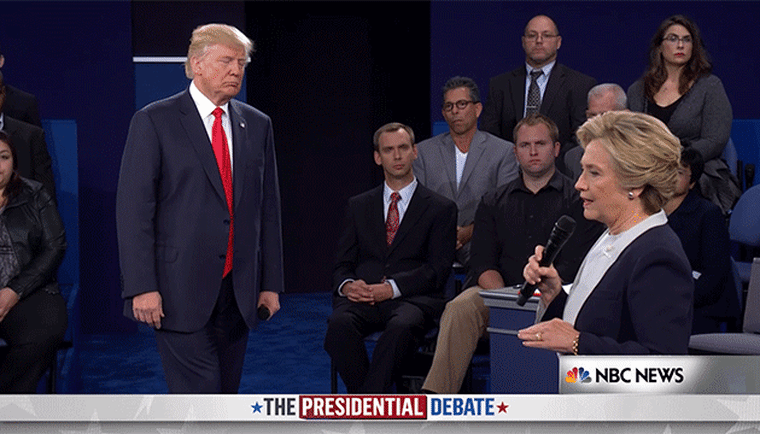Tension heightened between Donald Trump and Hillary Clinton at their second presidential debate, but the way each of the nominees handled the acrimony was widely noted by political pundits and armchair quarterbacks alike.
The meandering answers by the candidates were matched by the wanderings of Trump across the debate stage. Was there a reason for the Republican’s body language? Here’s a look at that and other burning questions that emerged during the second debate.
1. What was with all the pacing, gripping and lurking?
At this debate, the candidates didn’t stand behind lecterns. Instead, because of the town hall format of the evening, each nominee was free to sit in their high-top chairs, or stroll about the stage.
Trump did a lot of the latter.

Twitter immediately noticed the way he wandered about, sometimes pacing back and forth, and sometimes walking right up to Clinton, almost appearing to be lurking behind her.
At several moments, he also chose to stand behind his chair, gripping the top of it — and that, too, was noted.
Clinton also took a turn ambling about the stage, although for the most part she either sat in her chair or stood in place on the stage, waiting for her chance at rebuttal, while her rival spoke.
Some on social media compared Trump's pacing and lurking to the infamous sighs that came repeatedly from former Vice President Al Gore to many of the answers provided by then-Gov. George W. Bush during their first presidential debate in 2000.
2. Who made up the audience?
It wasn’t as easy as buying or reserving a ticket. For this town hall debate, the people on the stage with the candidates were selected by the research and polling organization, Gallup, according to the Commission on Presidential Debates. The roughly 40 individuals were uncommitted voters — people who have not made up their minds, or who may be learning toward one nominee but could be persuaded to switch before Election Day.
Half of the questions were posed directly by the participants on stage, while moderators asked the other half, based on questions suggested by social media users.
3. Pass the tissue, again?
During their first debate, Trump blamed a bad microphone for what America insisted was a series of sniffles throughout the night.
This debate, there was no debate: Trump clearly sniffed again — and often. And this time, his sniffles were long and deep.
They also were annoying to many on social media.
During the first debate, Trump’s sniffling was ridiculed because of the timing: The Republican had just suggested Clinton was unfit to be president because she had just gotten over pneumonia. This time around, Trump's sniffles became entertainment fodder once again.